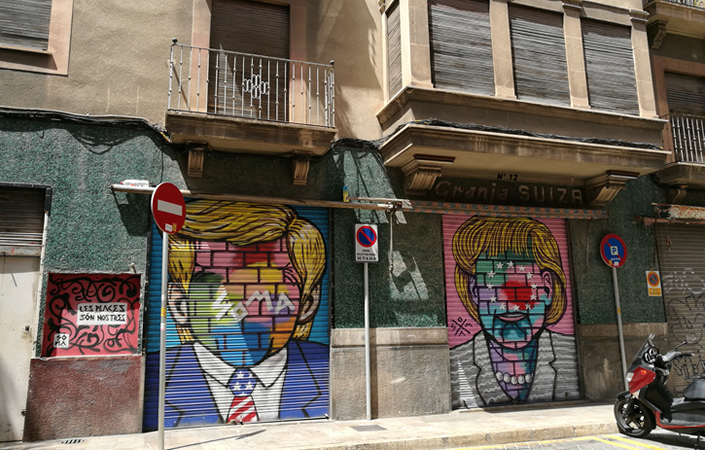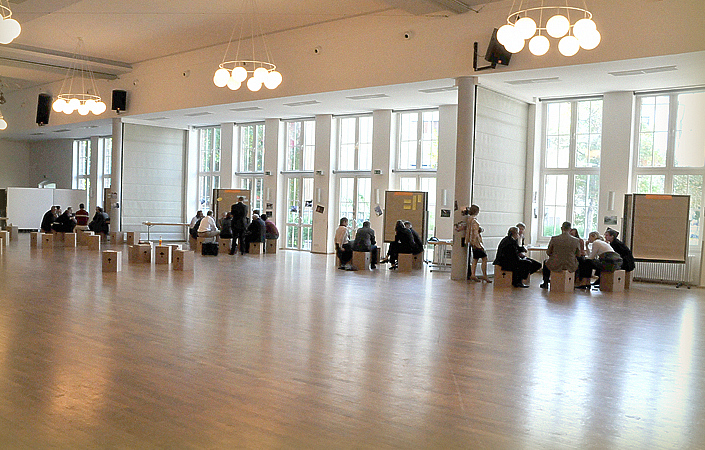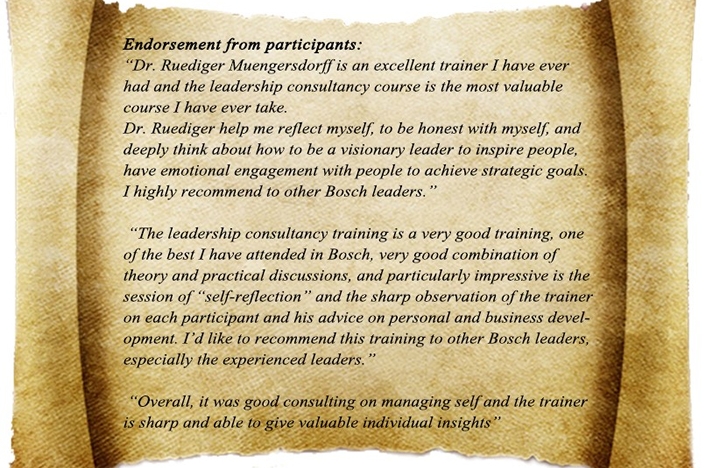20. August 2018

The last years have seen radical change to the environment in which businesses have had to operate for success. The field is increasingly grasped by VUCA – volatility, uncertainty, complexity and ambiguity. Digitalization, globalization and growth of networking generate a degree of complexity that is increasing exponentially and is no longer manageable by traditional methods of leadership and cooperation. This alters the fundamental rules of creating and gathering value.
At the same time, businesses find themselves engaged in a War for Talent in light of a growing scarcity of skilled workers. Employer amenity and employee retention are ever more intensely crucial competitive advantages. Young members of the oft-cited Millenials and Generation Z have raised expectations of their employers. Against the background of an overall cultural development that increasingly emphasizes a striving for autonomy and individualism, they want their experience of life to be a lifetime of learning under ideal work conditions marked by intrinsic motivation and meaningfulness without dominance from above.
Success for a business is therefore defined by that company’s answer to the following two questions: How do we add value by distributing and efficiently tackling tasks under most complex conditions? How can the human factor be reinforced in the company and the potential of intrinsic motivation be meaningfully raised?
The role of management is central to this context. In a new form, it can provide the basis for enabling the above-named two-fold creation of value. Motivational research has identified meaning, autonomy and the sense of improvement as crucial factors of intrinsic motivation (see, for example, Dan Pink). The same factors at the same time support complexity manageability. It is therefore a pivotal component of agile management to design an environment that provides for these three factors to have a maximum impact for the people as well as the success of the company.
Purpose and framework: guides amid complexity
In the VUCA situation, clarity is eradicated by the complexity of stakeholder interests and demand, employees face a new situation every day: clear and firm goals as well as sticking to rules and processes are no longer effective. Instead of a firm distant goal that cascades ‘top down’ along a hierarchy, agile leadership raises an open field of goals that is iteratively approached and becomes more concrete with every step. Always applying the currently most attractive factors, a nearby goal is brought into focus and approached in the short term, to be reached with a precise method. Of crucial significance for the employees in this context is purpose: a clear and stable vision that provides direction and meaning without cutting available freedoms. As it adds meaning as well as value, purpose provides employees not only with a direction but also with intrinsic motivation and strong identification. Agile leadership replaces strict rules and rigid processes with frameworks and principles. Frameworks demarcate the space within which employees can autonomously create meaning and add value. Principles define a clear scope of behaviour within which it is still possible to react to individual situations.
Enabling self-organization in order to tackle complexity
Following Ashby’s Law of Requisite Variety, a more complex environment demands greater management complexity in order to be tackled. In VUCA situations, the classical hierarchical model with one top manager in charge of all decisions is prone to difficulties. The expert at the top becomes a bottleneck; the hierarchical model is too ‘plain and simple’ to match the complexity of the situation. It is therefore the central task of agile leadership to build up self-organized teams who can take decisions by themselves in autonomous processes. Self-organized teams massively increase the modality range of (temporary) leadership, cooperation and decision-finding, so that complexity is more likely to be mastered. At the same time, the autonomy entailed in self-organization is intrinsically motivating. Agile management must therefore enable and empower self-organized teams and keep them accountable.
Creating a system of continuous learning
In simple and straightforward environments, it is a proven method to first analyse a situation and then proceed to meaningful action on the basis of that evaluation. The VUCA situation undermines this process and drains its efficiency: complexity and dynamics radically shorten the lifespan of an analysis. In these kinds of situations, greater success has been achieved with a different process, namely to act first and create an empirical basis of experience, then evaluate in the short term which action was successful (and which was not) and eventually optimise the efficiency of each action and creation of value. It is a continuous learning curve, in which the experience of learning and helping others along become pivotal factors of success and essential motivators. The implementation of regular reviews (regarding the product/concept), retrospectives (regarding the type of cooperation) as well as permanent identification of impediments and clear feedback (regarding achievements and relationships) are crucial tools of agile leadership. All that cannot be achieved without establishing a learning culture in which mistakes are considered valuable opportunities for learning and put to good use. Fail fast is the central mission statement of agile management.
Cultivating Leadership
Traditional hierarchic organizations take the manager to be the driver who directly designs attainment and treats the field under their management as a machine to be perfectly configured and kept regulated, on course and well-oiled. The dominant metaphor for agile management, on the other hand, is that of a gardener who ensures that a living ecosystem continues to prosper and thrive. Agile management designs the environment, establishes the conditions, removes impediments, supports drive, fosters synergies, etc. Thereby, it acts first and foremost indirectly. It empowers and commits employees to be held accountable without abandoning them to their tasks. It makes sure that employees can adequately handle stress, conflict and tensions by themselves. It helps people help themselves. Agile leadership is therefore always also cultural and developmental work.
Agile transformation
The paragraphs above deal with the agile management of teams; the same holds true for the management of whole organizations. Instead of changing organizations towards a tightly set and long-term goal by way of hierarchically directed change management from A to B, agile leadership will keep its own company in a constant process of transformation as a learning organization guided by the leading light of a clear purpose. In the past, strategic topics were driven into the company in top-down deployment. Now, in the VUCA situation, agile leadership ideally lets them emerge out of the self-organized potential of all employees; business fields are born co-creatively, tested on a small scale, then developed step by step and, if successful, enacted in the large scale. As in traditional organizations, agile management functions as a model: if you wish to introduce agile values such as commitment, openness, focus, courage and respect into the company, you must first and foremost integrate these into your own management work and bring them to life in your own behaviour.
Johannes Ries
Photo: Hanna Göhler
Post Scriptum: This text was initially sketched out in the context of an ongoing co-creative initiative on Agile Leadership by Robert Bosch GmbH and SYNNECTA. This blog will continue to report the outcomes of this initiative. The author wishes to thank the members of the Co-Creation Team, Michael Knuth, Jörg Jockel, Dennis Heine and Martin Hurich, as well as Christian Fust for their valuable contributions.
25. April 2018

On the agile triangle (methods, structure, culture), one of the most difficult aspect remains that of cultural change; that is neither new nor surprising. What we call culture is a combination of many factors that cannot be grasped by causal thought and are therefore hard to influence by the usual methods of change management. Culture is not a thing that we change, it is something we live, that we bring to life by ourselves and our interaction with others.
There is a particular notion of the kind of person, or colleague, who we consider to be the basis of agile work methods, of work and life in agile organizations: it is usually a construct of young people from generation Y or Z. Structures that are more democratic, have a reduced hierarchy and are self-organized must be in touch with the life concepts of individuals if they are to work. It is no surprise that it has to be said: these »identities« are rare in the companies of today. Identities cannot easily be exchanged, it is not possible to simply adopt a new identity; yet we expect employees to do just that. In doing so, we experience that the models looking to a future of »new« work often fail to see the people performing in the companies.
We are facing the challenge of developing new identities for modern organizations. Not only companies can fulfil this task: in fact, it pertains to the social identity structures of our society.
Identity is rather a continuous process, in which people understand and design their life – in a psychological, social, political and philosophical dimension. A central aspect that touches on all dimensions is the understanding of work and the significance of work to the development of identity. This process is where we have to interject. That means that we need to address the significance of status, upward mobility, the meaning of life that is communicated through work in an accepted structure. Even where colleagues want to break down hierarchies today, their creation of identity cannot fit with the thought of a lateral career: they are attached to the expectation of hierarchical promotion and status gain.
As identity is a process, a negotiation between agents and by agents with structures, we can work on a process of identity for new organizational forms. This is where the boundary between work identity and social identity collapses; I can find the necessary conditions only in urban life designs.
As a process, it passes through several stadia. These include moments of confusion, judgemental comparisons with others, a tolerance for new forms of trying one’s own role, an acceptance of the new stage of identity, a development of pride and eventually the integration of the ‘work identity’ into the entire spectrum of the personal identity. It makes sense to describe this as a journey, which becomes easier when it is undertaken together with partners. It is probably necessary that these processes are accompanied. To achieve this, there are individual coachings as well as, especially, supervision concepts for groups. Looking for a way into this process, it is promising to address the topics of diversity and inclusion. Tackling these issues opens people up and lets them develop an openness for their own process of identity formation. At the same time, we must not overestimate the achievements that are available to a company in this process vis-a-vis dominant conditions and values. It will therefore be necessary to find people who are already on their way to living a different work identity.
Rüdiger Müngersdorff
20. April 2018

The group was silent. They stayed silent, even as the inviting manger tried to send an optimistic and constructive message. Questions were ignored or answered with vague and irrelevant responses. Although the conversation livened up a little in smaller groups, it still lacked clear statements that would have explained this highly unusual behaviour for a group in a work environment. I was faced with the remnants of a group, and an organization, in the aftermath of a failed agile experiment: silence, disappointment, sadness, discord. What had gone wrong?
It was not simply the manager’s doing. He had a very clear understanding of agile methods, agile forms of organizations and he clearly demonstrated that he had reflected on his position and his behaviour and was still doing so. Still, he had underestimated some of the social and psychological dynamics of his experiment.
Later on in the day, we were able to talk about a few of the reasons for the situation this organizational unit found itself in. This did not resolve the deep disappointment and loss of trust in oneself and the company, but it aided a more realistic appraisal. Which circumstances had been obstacles, where was the learning potential?
1. The project employed brilliant people with a good education, high commitment and a passionate pursuit of their ideas. They were to be different from the majority of the employees in this global, very well organized company. They were promised a place where they would be able to pursue their ideas, realize the projects that were closest to their hearts. The beginning was enthusiastic, teams emerged, the work was highly satisfactory. Then, however, the organization interfered with their own strategic notions. These often did not correspond with the dreams and hopes of the employees. Financing was discontinued from some projects – a logical and sensible step from the viewpoint of the company, yet a brutal stop for a new idea with a future which had seen great progress towards realization within a short time. The employees were neither able nor willing to understand the reasoning, and doubted the economic considerations. They were shifted into new projects, new beginnings: the essence of what had filled them with such a deep sense of meaning was gone. Although they were placed into an equally free and self-organized structure, it lacked the content, the emotional attraction. At this point, others left the company already. The mourning of lost projects was tangible during our workshop, it cast a long shadow over everything. However, it was not discussed, like a secret that everyone was aware of. Organizations that are characterized by their participants’ commitment and passion need farewells and rituals of mourning in order to free people up for something new, for a new passion. It is difficult to have a burning passion for a product idea in a context of dependent employment: working with people who want to be committed to facing problems, clients, possibilities seems to have more promise.
2. Following the textbooks, they nominated a Scrum Master, also a brilliant young man, with a lively, fluid intelligence and degrees from several top universities. He was good, but couldn’t put a halt to his own being the best of the best: he was unable to control his urge to be part of the actual work in every field by bringing in his knowledge, his ideas. He tried, quite dogmatically, to communicate the rules and demanded discipline. He lacked social skills, control of his narcissism and an understanding of the task and role of a methodic and social guide. He was the wrong man for this task. Social skills are rarely learnt at top universities.
3. The people were placed in an agile work context without a deeper understanding for the dynamics of an agile, self-organized structure. Their own psychological contract with the company, however, contains many elements that are not agile: these include an understanding of having become part of the system upon entry into the company, a system that takes care to provide a safe place and relieve any concerns about uncertainties of the future. They had entered a safety zone with the promise of a long career. The expected all the freedoms as well as a manager to provide a direction, carry the weight of decision-taking and provide a solution in cases of conflict. What they got was a general strategic direction, a discussion partner and someone who made sure that cooperation with the umbrella organization would work. They did not get any decisions on the content of their topic, their project. That in itself was too much. When it was then decided that the feedback talks would be conducted in the groups themselves, they were completely out of their depths. As no-one had any knowledge or experience of group dynamics, situations escalated and/or the system was paralysed by silence.
4. At first, all doubts, contradictions and uncertainties were compensated by the participants’ own enthusiasm for their own topics. As time went by and projects were lost, it had to be admitted that dreams were just illusions and questions arose: questions about the future, about security, questions that pop up once the buoyancy of enthusiasm is gone. Where careers, securities and rewards had initially been irrelevant, their significance now started to grow. A new importance was given to the future and to career paths. Promotion was the crux, and the notion of lateral careers only caused disappointment. A company that was unable to offer an upwardly mobile career became unattractive.
Following long periods of silence, we were able add up fragments of the pain and disappointments and at least establish a higher degree of truth. Scenarios for a new beginning were sketched out. For some, there emerged another opportunity to re-immerse themselves into an agile world with more understanding. Others gained the clear knowledge that agile self-organization was not the place for them. Some are leaving the organization – the headhunters are lying in wait. The clarity we gained made it possible for individuals to take decisions and forge a path on which to turn the lessons and experiences into a new attempt.
Clarity and the truth about agile organizations need to be told unmistakeably from the start. There has to be an understanding that the participants require a high degree of social competence in order for the journey to succeed. The position of an Agile Culture Coach should be a matter of course. And finally, we need to accept that we still have only few ideas when it comes to showing paths into the future for people in organizational structures of this kind: paths that can be an attractive alternative to the model of vertical careers.
Rüdiger Müngersdorff
6. February 2018
Together with the following endorsement of one of our trainings we were asked, what is the difference between a good leadership-training and a five-star training?
The answer is relatively simply – don’t elaborate on one of the uncountable leadership theories but give people the chance to reflect their current and future positions, create a space, where they can discover their own personality and emotional condition.
Or very simply: get personal.

22. January 2018

As organizations are growing increasingly sensitive to agility, we gain new ground for experiments. This blog text will introduce a sprint workshop format, which has evolved from such an experiment and has yielded good results in several projects.
I developed the first prototype several years ago from a certain sense of frustration when a leadership workshop with 50 high-ranking managers focused on the topic of agility had come to a dead end. Instead of working on the topic, we had got stucked pseudo-discussions, which had prevented any form of deeper reflection. A tactic of constant commentary had made it impossible to draw any conclusions. Even continuously making the group aware of the destructive patterns at work had not generated any effects. Somehow we still managed to take the workshop to a minmal goal. Yet participants and moderator alike were left with a sense of frustration.
During a follow-up, the courageous internal project leader and I concluded that if this group was to be given value and effectiveness, the next workshop would have to utterly break the pattern. From this insight, I developed the sprint workshop format, which I will describe below. This new model not only helped to introduce the group to a productive discussion of relevant topics and allow them to develop tangible and significant measures, it also proved of value to several other large groups in other contexts. I now use this format on many occasions in order to achieve an effective approach to agile principles within concrete work on pressing and complex issues.
On the one hand, the format aims to trigger the three intrinsic motivators of the human being as prominently described by Dan Pink: Purpose, Autonomy and Mastery. On the other hand, it adopts the advantages of Scrum or sprint logic combined with continuous feedback. The following framework is given:
1. Creating a topic backlog (90 min)
The participants are grouped into small teams of approx. six persons each. Together, they begin by gathering the challenges and impediments they face in the current situation under the lead of an appropriate guiding question. They then write user stories from the perspective of appropriate stakeholder or target groups (there are templates to support this process), in order to work on the given challenge or remove the given impediment.
In a leadership workshop, the user stories might, for example, look like this:
- »As an employee, I want to regularly be given guidance about goals from my management, so that I can plan for myself appropriately.«
- »As a colleague, I want to receive maximum support from other managers, in order to really be able to fulfil the complex goals I am responsible for.«
- »As a supervisor, I want managers in my charge to inform me of problems early on, so that I feel secure.«
All user stories emanating from the discussion are then presented in a plenary session. The next step is to order them by priority. This works well with simple swarm evaluation: each participant has the same number of points that can be allocated to the user stories. These are then sorted into a topic backlog according to the points they received from top to bottom.
2. Sprints (90 min each)
Once the topic backlog is done, we enter the sprint mode. The participants are divided into cross-functional/diverse sprint teams (five to seven members each), whose work on the backlog topics from top to bottom. The target is to conclude concrete measures in response to the user stories and conceptually secure their realization.
2.1. Work phase (45 min)
The work phase of every sprint sees each sprint team ‘pull’ the given top topic and work on a prototype of measures, which is to be presented on a poster board. The provision of canvas posters has proved helpful; with the help of guiding questions these canvases provide a rough frame of orientation, but are completed in autonomously organized brainstorming, discussion and conclusion phases that are not externally moderated. It is the aim that each sprint team presents the prototype of measures on the poster board in such a way that it can be presented without further explanation. Once the sprint team considers a user story sufficiently translated into measures, it ‘pulls’ the next top user story from the backlog and immediately starts work on that story. Each work phase begins with the nomination of a silent observer from among each team. This person will silently observe the team during the work phase in order to provide feedback later on.
2.2. Review: market place (15 min)
Following the market place logic, the work phase is succeeded by a review of the measure prototypes. In this phase, a representative of the sprint team will remain with their own team’s poster board, while the others swarm out in order to view or be introduced to the prototypes developed by the other sprint teams and provide feedback on the given progress status. The sprint team representative will collect the feedback given, so that the team can optimize their prototype of measures during the next sprint, where necessary.
2.3. Sprint team review (15 min)
Each sprint team will then come together again. The observer will take five minutes to inform the group of their insights, address impediments that were observed and provide suggestions for improvements to be made during the next sprint. Within the next five minutes all sprint team members briefly reflect on their experiences of the team perfomance during the work phase. The last few minutes of the review are to be used for one-on-one dialogues during which the sprint team members each provide feedback on their observations of their opposite’s individual behaviour during the work phase.
2.4. Break (15 min)
There is a break before the next sprint begins.
The next sprint takes the same form as the first sprint. If the sprint team has received feedback from the other participants that the measure prototype is not yet sufficient, work continues on that prototype. Once the entire group has approved of the prototype, the sprint team will proceed to get the next topic. A new observer is chosen and autonomous work on the topic will begin…
3. Concluding session (60 min)
The finalized measures will be briefly presented once more during a final round and will then be concluded together, unless there is a veto. The sprint workshop ends with a final round of feedback, during which individual experiences with the format will be shared and conclusions may be drawn for a follow-up event.
A one-day sprint workshop of this type can include a total of four sprints and thereby achieve great effectivity. A workshop of this format over the course of one-and-a-half or even two days can generate an impressive number of measures with a great likelihood of realization. Templates of measures, guiding questions and sprint duration can be individually fitted to the given target group, thematic focus and duration of the workshop; even intermediate plenary sessions or general reviews can be included. The overall framework of the format described above, however, has proved to be particularly sustainable and especially productive in this shape. Participant feedback has time and again stressed the amazement experienced in the face of the focussed and productive effect of the format. At the same time, many participants have reported that they themselves attained a valuable approach to agility from their own experience of sprint logic, reviews and feedback.
Johannes Ries





